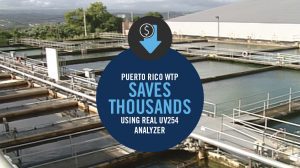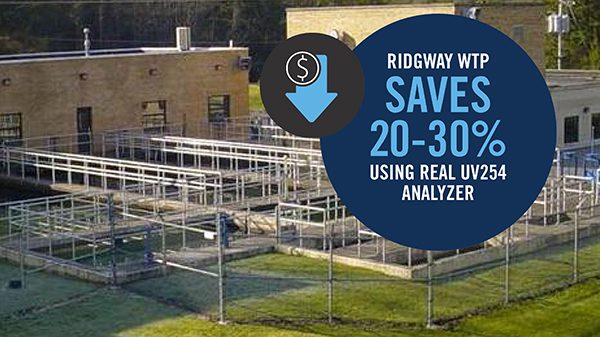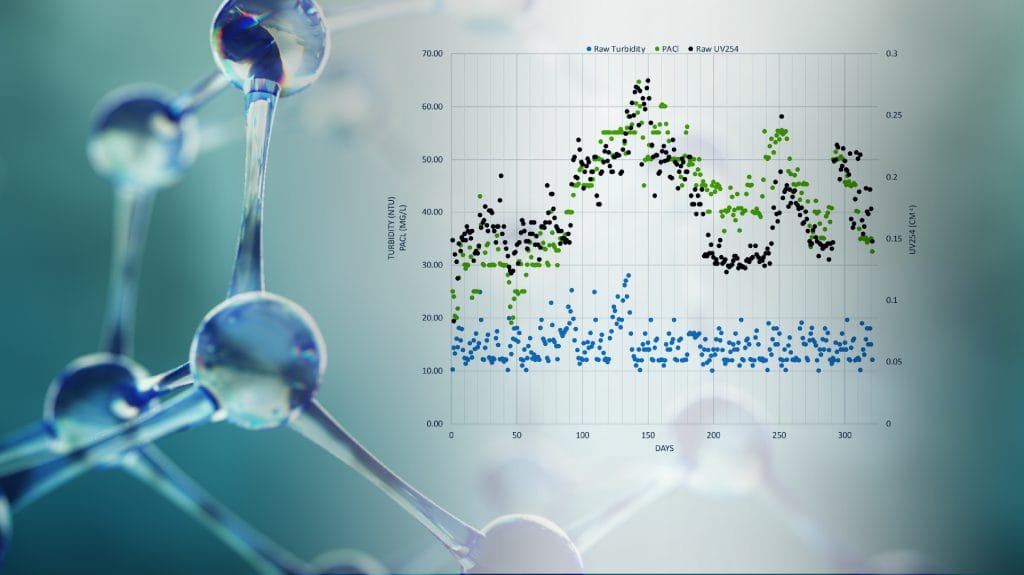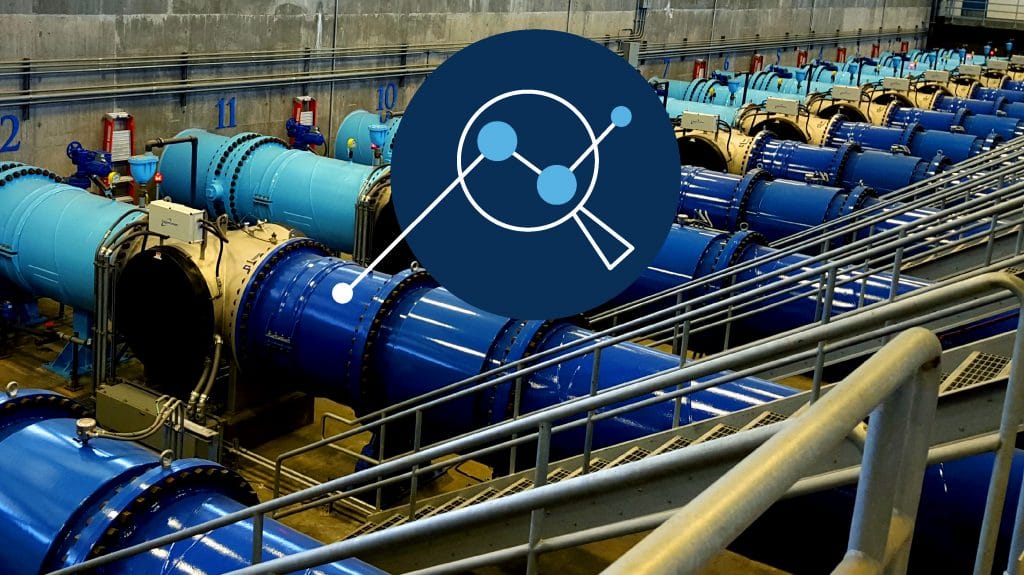 The Los Filtros Guaynabo Water Treatment Plant in Puerto Rico installed a Real UV254 M3000 analyzer to monitor raw water organics fluctuations and feed a coagulation optimization system supplied by local partners Montanas Electric, Inc. and Nator Corporation. With reliable real-time organics information the plant was able to automate their coagulant dosage, improving efficiency while maintain finished water quality and reduced their coagulant usage by an average of 23%.
The Los Filtros Guaynabo Water Treatment Plant in Puerto Rico installed a Real UV254 M3000 analyzer to monitor raw water organics fluctuations and feed a coagulation optimization system supplied by local partners Montanas Electric, Inc. and Nator Corporation. With reliable real-time organics information the plant was able to automate their coagulant dosage, improving efficiency while maintain finished water quality and reduced their coagulant usage by an average of 23%.
Background
Dealing with fluctuating water sources is not an easy task for plant operators. Seasonal variation, heavy rain fall, or accidental contamination events change the raw water quality, requiring immediate attention. This is a familiar scenario for Facility Manager, Nancy Ma. Cáceres Acosta at the Los Filtros Water Treatment Plant in Puerto Rico. She has been producing high quality water for 256,000 residents, receiving surface water from the Guaynabo and Bayamon River.
In an initiative to improve plant performance, Sra. Cáceres Acosta coordinated with Daniel Smith of Montanas Electric, Inc. and Orlando Laguer of Nator Corporation to integrate a coagulation optimization package at the facility. Key aspects of the package included a Real Tech UV254 organics analyzer, dosing control panel, and remote telemetry system. Results of the control package exceeded expectations, saving the plant an average of $9,831 from chemical reduction. In addition to the initial cost saving on chemicals, the plant is confident their formation potential for DBPs is limited, increasing water security.
The Los Filtros Guaynabo Water Treatment Plant (WTP) in Guaynabo is located on the northern coastal valley of Puerto Rico. The plant has the capacity to produce 30 millions of gallons per day (MGD) of drinking water serving approximately 256,000 local residents. Source water for the plant is drawn from the Bayamón river basin, springing from the mountains into the Bayamón River and main tributary, Guaynabo River (Monroe 1980). The two rivers have historically been impacted by both naturally occurring and man-made organic matter. The murky waters are saturated with natural organic matter (NOM) comprised of humic substances as well as anthropogenic organic pollutants from the surrounding land practices (Cáceres Acosta 2013). Heavy rainfall events around
the island are accompanied by soil erosion, causing the rivers in the basin to “run red”. High organic concentration, color and turbidity (NTU) associated with the rainfall events have always posed operational challenges for the receiving plant.
A Closer Look at Conventional Water Treatment
The Guaynabo WTP is a conventional filtration drinking water facility. The raw water delivered from the intake facilities enters a rapid mixing chamber where chemical coagulant is added. The pre-treated water moves to the flocculation basin, then proceeds to one of the five sedimentation tanks where floc settles from the water. Settled water moves through eighteen sand filters to further remove any dissolved matter. Filtered water is then dosed with chlorine for disinfection before moving to the distribution tank (EPA 2009). The facility is required to meet regulations associated with the Safe Drinking Water Act, including compliance with the Environmental Protection Agency (EPA) Stage 2 Disinfectant/ Disinfection By-Product (D/DBP) Rule. The D/DPB rule
protects consumers from harmful disinfection byproducts (DBPs) such as Trihalomethanes (THMs) and Haloacetic Acids (HAA5).
Historically, the facility has had an excellent record remaining in compliance despite the challenging source water. In an initiative to improve plant performance and gain a better understanding of the raw water NOM, Facility Manager Nancy Ma. Cáceres Acosta was interested in investigating technologies for detecting organics that would assist in plant optimization.
An Efficient and Economical Approach to Plant Optimization
Optimizing plant operations, minimizing operating costs, and remaining in compliance were the goals Sra. Cáceres Acosta articulated in her first meeting with local Instrumentation Specialist, Daniel Smith of Montanas Electric, Inc. and System Controls Engineer, Orlando Laguer of Nator Corporation. Assessing historical water quality trends, Mr. Smith and Mr. Laguer designed a complete monitoring and dosing system that would address the issue of organics detection with UV254 (ultraviolet absorbance at 254 nm) as an indicator of NOM.
UV254 has a biased towards reactive aromatic organics that tend to be most problematic for operations. These organics will readily consume coagulant and combine with chlorine to form DBPs. Therefore, monitoring aromatic organics with UV254 was deemed an important parameter for calculating optimal dose. Instant notification (10-15 seconds) of organic contamination events was also valuable to monitor fluctuations in raw water that had historically posed operational challenges. The UV254 M3000 model from Real Tech Inc. was installed with dual feed capabilities to monitor both raw and post filter streams as an indicator of process efficiency and to establish TOC equivalent values. The package was controlled by a local plc HMI Dosing Control Panel with all historical water quality data. This information was used in conjunction with real-time water chemistry, as presented in Table 1, to aid in the development and future
control of an optimal dosing program. A custom algorithm was formulated for the program to automatically adjust chemical dosing, allowing for significant reductions in chemical coagulant while meeting the required TOC removal percentages for compliance.
Small Changes, Big Results
Results from the UV254 monitoring and dosing control package were greater than expected. Data collected from an eight-month period of continuous operation was compared against the corresponding months from the previous calendar year. Comparison of monthly polymer consumption in pounds is displayed in Figure 1. On average the plant experienced a 22,917 lbs reduction in chemical coagulant usage per month. This equated to a decrease of 23%, allowing the facility to save $9,831 USD on average per month as shown in Figure 2. As a result of optimizing the chemical coagulant dosage, the facility also realized a reduction in filter bed backwash cycles of 23%. A decrease in backwash frequency meant more water in the system for production. Additionally,
a significant 23% reduction was seen in sludge formation which in turn decreased removal costs. Beyond the cost savings and optimization, the facility remains in compliance, meeting the required TOC removal and improving DBP control.
________________________________________________________________________________________________________________________
RELATED POSTS
HOW A SIMPLE ORGANICS MONITOR HELPED REDUCE CHEMICAL COSTS
ORGANICS AREN’T INVISIBLE: A GUIDE FOR SIMPLE ONLINE MONITORING
A GUIDE TO SOURCE WATER MONITORING
GO BACK TO BLOG
![]()



